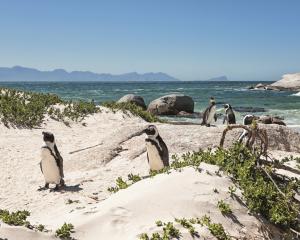Dennis and Rosamund Knill stay in one of Australia's most isolated camp sites and experience the ultimate destination for nature lovers and eco-adventurers.
South Australia's Eyre Peninsula might have been invented to provide the perfect holiday adventure but just a little further north is one of the most stunningly beautiful, wild and untrammelled outback areas you will ever see.
In less than three hours from coastal Port Lincoln you will find yourself in another world, among diverse plant life, exotic birds and wild animals.
It is fierce and uncompromisingly stark out here and by and large untouched, but for a few all-embracing tourists wanting to escape the stresses of city life.
This is a harsh place: if it's not floods, it's droughts, if it's not droughts, it's fires and the blistering heat painted in bright red.
And everywhere you look there is life: kangaroos engage in Mexican standoffs, emus streak across barren grasslands, parrots bask on branches in the sun as wedgetail eagles gaze down austerely from the clear blue sky above.
It's as if nature has put on a play and we are the audience lucky enough to have the best seats in the house.
It's a brilliant Sunday afternoon at Port Lincoln Airport and we are met by Geoff Scholz, who with Irene, his wife, operates Gawler Ranges Wilderness Safaris.
Previously wheat farmers, they wanted to share their passion for the outdoors and the wildlife, so they finally sold up and established their wilderness dream.
Introductions made, we head to Mikkira Station to view a colony of wild koalas asleep in their own habitat, low in the gum trees.
We then travel up to Kangaluna Wilderness Safari Camp, our base for the next four days, for an afternoon tour that includes lunch and sunset drinks at Kolay Minca Rocks.
Along the way there are emus and kangaroos everywhere, reds, greys and wallaroos.
And we have luck on our side: we spot the odd wombat feeding out of its burrow and two shingleback lizards.
After returning to the camp, we are shown to our tent, but this is no ordinary tent, in no ordinary camp; it is literally built around nature.
Deep in the outback, hundreds of kilometres from Adelaide, the camp accommodation consists of three solitary tents and a covered wagon from a bygone era.
The feel is eco-cool with just enough mod cons to meet our expectations.
Each tent is powered by solar panels.
There are two bedrooms, comfy king-size beds, recycled timber furniture, a bathroom with toilet and shower and tea-tree toiletries.
Meals are served in a large dining room, its distinctive feature being the extra-long dining table that doubles as the perfect spot at sunset or early morning to view the birds and wildlife that wander into the camp each day.
Over the next four days, this cosy accommodation will provide us with a comfortable base to explore the pristine wilderness, ranging from five-minute walks within the camping grounds to full-day 4WD wilderness tours.
The daily tours can be quite taxing, the distances covered vast.
Each tour is designed to take you across changing landscapes, stock routes and sheep stations.
Most of the roads have rarely seen a grader, a true test for even the best-engineered 4WDs as they need to be able to navigate a combination of rugged unsealed dusty corrugated roads and sand dunes.
On day three, we rise at 5.30am for an early breakfast and at first light we sight a flock of colourful parrots and a dozen kangaroos drinking from the water troughs and water bowls hanging from the trees.
We climb into Geoff's 4WD for a four-hour drive to Lake Gairdner, which is often referred to as the jewel of the Gawler Ranges.
Like a piece of the Antarctic, the glistening white brightness of the salt surface makes a stunning contast with the red of the surrounding landscape.
The endless sheet of thick white salt stretches as far as the eye can see.
The reflection is so intense we have to shade our sunglasses with both our hands.
In 1857, when Stephen Hack discovered the 160km-long salt lake, he recorded in his log that this was one of the most spectacular sights to behold on the continent.
En route back to the camp base we drove through more changing landscapes, passing striking volcanic rock formations created by a huge eruption more than 1600 million years ago.
It is our last night at the Kangulana camp and there's a full moon, so our hosts cook us a hearty meal by the outdoor fireplace under the stars. On the menu is a fair-dinkum Aussie dinner: barbecued Tasmanian salmon, salad and dessert with all the wine we could drink.
Our final day takes us to Baird Bay, where we meet Allan Payne and change into our wetsuits to swim with sea lions and dolphins off Jones Island, a leisurely 15-minute trip from the mainland.
With snorkels and fins we enter the water and are immediately encircled by curious and frolicsome seals determined to investigate at close quarters and play for as long as possible.
Our four-day outback experience quickly comes to an end and as we fly out of Port Lincoln we pondered if we might have been able to have done all this on our own.
Well, we probably could have, but it would have taken a lot more planning and time, a reliable vehicle, truckloads of food and water and masses of research.
• Dennis and Rosamund Knill were assisted by Air New Zealand, South Australia Tourism Commission and Southern Cross Travel Insurance.
Need to know
Getting there: Getting to Port Lincoln is relatively easy and a mere 25-minute flight from Adelaide. Air New Zealand flies direct to Adelaide from Auckland five times a week.
Background reading: Set off to the Gawler Ranges, by Anne Jensen, Adelaide and South Australia, by Susannah Farfor, South Australia Horizons and Beyond, by Tony Baker.
Further information: www.gawlerrangessafaris.com and wwwsouthaustralia.co.nz












